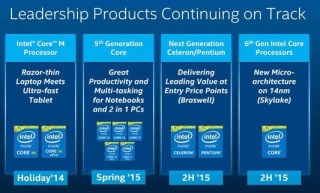So Intel has decided to make the lunch date for their new 5th gen Broadwell and 6th gen Skylake to be both in 2015 to 2016.
I always though 4th gen was pretty powerful with the 22nm chips, until I discovered what the 5th gen cpu can do with only 14nm with still a max of 4 cores. What tickles my curiosity is why they launched 2 generations of cpu’s in consecutive years.
The broadwell chips will be the more mainstream chips in desktop computing and had a delay in the manufacturing process, hence the release date being so close to the Skylake release date.
Intel boosted with their Skylake chips set in more laptops and tablets. With the new chips you can expect up to 8 hours of battery life, meaning more than one full HD movie with one charge. These chips with optimized security and gpu configuration for on-the-go usage will be a new found favorite for laptop and tablet users.
With a base clock speed of 3.0ghz on a 5th gen i7 chip, performance will literally be next level. The 14nm also ensure less heat is created so heat will be less of an issue. Cooler Master and Corsair will have to market their liquid coolers in a new way new. Although the Broadwell will have an unlocked version.
Broadwell won’t be coming to replace budget socketed desktop Haswell parts, though performance and HEDT parts should get the Broadwell treatment by mid-2015 as well. When it does come though it will see for the first time Iris graphics coming to socketed systems, which could give reason for AMD to worry, IGP graphics is its strongest and only niche it can compete well in at the moment.
Due to the initial 14nm production ramp up issues Broadwell is being rolled out quite late. By the time the new high end laptop Broadwell-H and desktop Broadwell-K parts come, Skylake (the next architectural refresh) will be just about ready to launch in the second half of 2015, giving mere months for some Broadwell parts before they potentially become outdated.
So while your 4th gen will still be good enough, the new gens will most certainly be something to look at, depending on your cpu. Some of the 4th gen k-chips will still outperform some 5th gen cpu’s. Only bad thing is that 6th gen cpu will be on a new 1151 socket. DDR4 ram will also only be supported on these boards. 5th gen will only go up to 1600mhz ddr3 but probably can be overclocked as I overclocked my 1333 ram to 1402(my motherboard stated it can only do 1333). Most high end motherboards will also handle the 5th gen so you are good to go to purchase one of those if you currently thinking of upgrade.
Bottom line is that where will always be something new from these guys. If you are not upgrading from 1st gen, then don’t wait for something better. Just go out and do it.
If you do need to upgrade and be set for the next 5 years, go for an unlocked 4th gen i7 cpu and a 4th and 5th gen board, for example the Asus Z97-k. Then later on replace the 4th with a decent 5th gen cpu.
Hope you guys learned something new with my post.
Cheers



